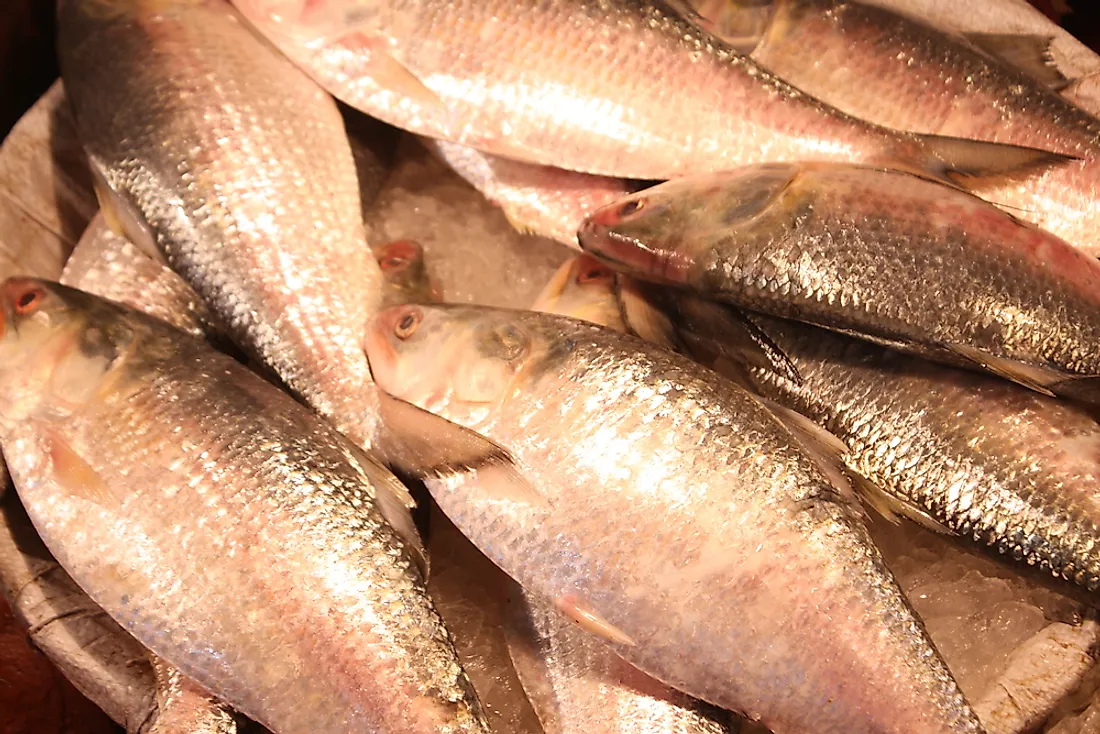Is the Hilsa Fish Being Eaten to Death?

The hilsa fish, more popularly known as “ilish,” is a popular dish in many parts of South Asia. Cooked with mustard oil or seeds, it is considered to be a mouthwatering delicacy in Bangladesh and in the Indian state of West Bengal. More than a dish, the hilsa fish transcends the culinary world to become a part of Bengali culture. Aside from its distinctive role as the national fish of Bangladesh, the fish finds mention in Bengali prose, poetry, and even cinema. Ilish plays an important role in festive occasions including wedding rituals and other auspicious ceremonies of Bengalis.
Unfortunately, the hilsa fish is in great danger today. To learn more, World Atlas caught up with two researchers involved in a study undertaken at the Jadavpur University in Kolkata, West Bengal that points evidence to this danger.
Plummeting Populations
The Tenualosa ilisha or the hilsa is a fish of the Clupeidae family. Due to its high demand, the fish is often referred to as the “King of Fishes”. The hilsa occurs in the Indian Ocean’s northern parts, including the northern Bay of Bengal. The range of the fish extends from the Persian Gulf to the coasts of Myanmar including both the eastern and western coasts of India. Its presence has also been reported in some parts of coastal Southeast Asia.
The hilsa is a marine euryhaline fish that migrates up rivers from the sea to spawn. The species is known to ascend rivers as far as 1,200 km upstream from the mouth of the river (but generally travels upstream for about 50 to 100 km). Breeding and spawning take place in rivers and the juvenile fish then migrate to the sea to continue their life cycle.
The hilsa is a highly valued fish that is noted for its great taste. Hilsa fisheries serve as the source of livelihood for nearly half a million people in Bangladesh, and thousands more in India. Millions of people are also indirectly involved in its trade.
The IUCN labels the Tenualosa ilisha as a “Least Concern” species. However, at the same time, the IUCN mentions that in recent years, Hilsa catches in India have rapidly declined. The situation in Bangladesh also does not look favorable for the species.
How The Hilsa Is Eaten to Death
In a recently published study, scientists have raised their concerns about the unsustainable nature of hilsa fishing practices in the northern Bay of Bengal. According to the study, a rise in the number of licensed fishing boats in the Bay of Bengal is responsible for the plummeting stock of Hilsa.
Ms. Isha Das, a senior research fellow at the School of Oceanographic Studies, Jadavpur University, Kolkata, and the lead researcher of the study spoke to us about why she chose to focus on the hilsa for her study.
“Hilsa was selected for the study because of its economic importance and the high number of fishermen involved with the trade, the high market price of the fish and its significant influence on the socio-cultural environment of West Bengal,” she said.
She also mentioned that every year, the hilsa catch during the monsoons sets the mark for the market price of the fish. A sizeable amount of hilsa is imported to India from Bangladesh to meet the skyrocketing demands for this fish. The annual catch data of hilsa provided by the West Bengal Fisheries Department, Government of West Bengal, shows that the annual catch of hilsa has decreased by 13% within a period of 14 years (from 2002 to 2015) in spite of an increase in the number of boats engaged in hilsa fishing by 25%.
Speaking of the initial objectives of her study, Ms. Das said:
“The notion of studying this particular issue came into my mind when the annual marine catch trends of West Bengal were reviewed. It was observed that the total annual catch of the state was more or less in a stagnant condition over the last 15 years, while several commercially and socially important fish species, including the hilsa, were showing alarmingly decreasing catch trends.”
“Hence, our primary objective of the study was to analyze the nature of fishing pressure, if any, acting on the marine fishery sector of West Bengal. We wanted to inspect whether the hilsa is being overfished in the northern Bay of Bengal.”
The results of the study conducted by Ms. Das and her colleagues revealed some hard facts related to Hilsa fisheries in the northern Bay of Bengal.
The present rate of exploitation of the species was found to be double of the preferred exploitation rate and indicated the overexploitation of the hilsa fish stock in the region. The study also pointed towards the deterioration of the health condition of the hilsa stock in its natural habitat which may be attributed to overfishing. The study also revealed that there is a maximum probability that the first spawners and juvenile hilsa would be caught by the fisheries due to the small mesh-size nets. In the long term, this is an unsustainable practice. At present, the number of boats operating in the northern Bay of Bengal exceeds the sustainable limit by far resulting in overexploitation of hilsa population.
A Pressing Need To Address The Issue
The popularity of the hilsa is undying. It is unlikely that demands for the fish will go down anytime in the near future. Thus, without the strict implementation of restrictions on hilsa fisheries, there is a high possibility of the hilsa being fished to extinction.
Professor Sugata Hazra, Director, School of Oceanographic Studies at Jadavpur University Kolkata said:
“Hilsa is being overfished much above its sustainable limit. The capture of the first-time spawners dominates the Hilsa fisheries. This might lead to the collapse of the fishery in the future.”
Prof. Hazra also suggested the following corrective measures be put into place to ensure the recovery of the Hilsa stock:
1. Strict implementation of the already existing fishing regulation on hilsa fishery.
2. The implementation of bottom trawl ban within 30 meter water depth.
3. A ban of zero mesh net in the estuary to save the hilsa.
4. In addition, efforts should be made to provide substantial assistance to hilsa fisherman while implementing 10 days abstinence ( five days before and after the full moon between 15th September to 24th October) from hilsa fishing during the winter spawning period.
The plummeting hilsa population in the northern Bay of Bengal is not only a concern for the local governments of the region but also indicates how high demands for a fish species and unregulated fishing activities can lead to species overexploitation. In the end, it will be the people who will lose if wild hilsa ceases to exist. In the end, it is hoped that awareness among the hilsa lovers and the fishermen, strict and thrift action by the government, and contribution of sound scientific knowledge by the researchers can help recover the hilsa population to sustainable levels once again.
**
Dr. Oishimaya Sen Nag is a freelance writer and editor from Kolkata, India. She loves to participate in wildlife conservation activities and to explore new places and cultures.











